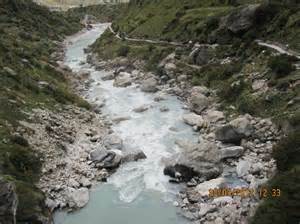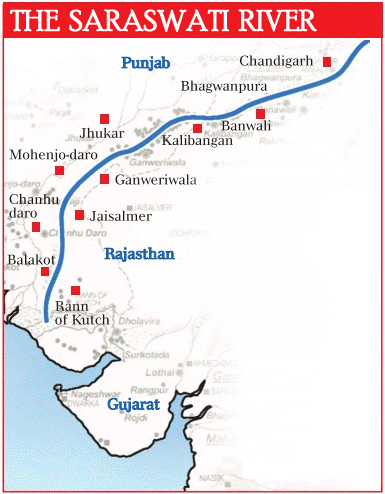Believed to be lost or dried up from the Indian soil, nearly 4,000 years back.
Saraswathi River a mythical Indian sacred river according to historians dried up somewhere around 4,000 years back. The miracle river which was 8 Kms wide and 1,800 Kms long originated from the Himalayas and run through the West coast of India. The holy river disappeared between 5000 BC and 3000 BC due to the tectonic events in the Himalayan ranges.

Today, historians and archaeologists have traced the track of the dead river in the holy city of Kurukshetra in the State of Haryana. Puranas depict Kurukshetra as a region named after King Kuru, the ancestor of Kauravas and Pandavas as mentioned in the great epic Mahabharata. Kshetra in Sanskrit means region. Kurukshetra’s importance is the war that is mentioned in the Mahabharata, while the other importance of the place is the Bhagavad Gita preached by Krishna, the Supreme Personality of God head, to his friend Arjuna in the battlefield of Kurukshettra.
Hindu mythology believe that river Ganges (River Bhagirathi and Alakananda) a 2,525 Kms river rises from the Himalayas and flows south and east through the North Indian states and meets the Bay Of Bengal in Bangladesh will dry up at the end of Kali Yuga (present yuga) as like River Saraswathi disappeared. The river Bhagirathi and Alakananda meet at a place known as Deoprayag situated in the State of Uttarakhand at an altitude of 618 mtrs to become the so called sacred river Ganges. According to a belief, Lord Ram and his father King Dasharath did penance here. The main temple of the town is the ‘Raghunath Temple’, dedicated to Lord Rama. The place is a beautiful holy place filled with myths and mysticism.
Now coming back to the lost and dried up river Saraswathi, the river is currently not identifiable in the Indian sub-continent and numerous theories were suggested to trace its route and origin. All these efforts taken could not have shed much light on the origins and disappearance of the river, but the Government of India is not going to leave it as it is.
Indian and international scientists say new evidence could unearth the Saraswathi. The legend of the mighty Saraswathi river has lived on in India since time immemorial. Ancient Hindu scriptures called the Vedas, recorded thousands of years ago, are full of tantalizing hymns about it being the life-stream of the people. Meanwhile,India’s remote sensing satellites have traced the buried course of Saraswathi, the mythical Himalayan river, kindling hopes of finding drinking water under the hot sands of the Thar desert in Rajasthan, the dry and colourful state of India.
According to some literature, the river disappeared between 5000 BC and 3000 BC due to tectonic events in the Himalayas that cut off the water supply, and climatic changes that converted what was once a lush green Rajasthan into an arid zone. Past attempts to accurately trace the lost river and reconstruct its drainage system did not succeed. Recent advancements in space-based sensors and in data processing technologies made it possible”, says J. R. Sharma of the Jodhpur-based Remote Sensing Service Centre of the Indian Space Research Organisation (ISRO). He and his colleagues, have mapped the path of the river and its tributaries.
While, the feasibility study of the National Water Development Agency has been going on for the last 19 years and is continuing. The government of India, with the assistance of hydrologists, geologists, archaeologists and space scientists, is trying to bring back the Saraswathi River, which dried up in Vedic times. The dry bed of the “mythological” river was spotted in satellite photos, five miles wide, coursing from the Himalayas to the Arabian Sea. Some water still flows along this course, but underground. The government’s attempt is to tap this water in wells and reservoirs, so that Hindus may once again be blessed by the Saraswathi’s sacred waters.
The attached photo is a satellite view of the Sarasvathi River basin running from the Himalayan Mountains to the west coast of India. Another a route map.


